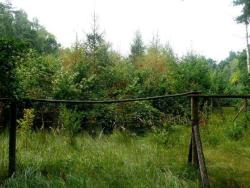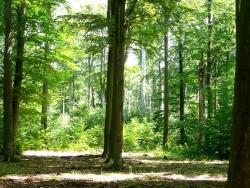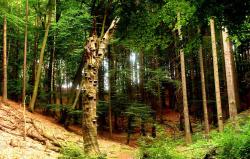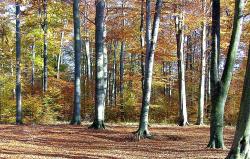 Asset Publisher
Asset Publisher
Forest Protection
 Jednym ze sposobów zabezpieczenia upraw leśnych przed zwierzyną jest grodzenie. Fot. Jerzy Wilanowski
Jednym ze sposobów zabezpieczenia upraw leśnych przed zwierzyną jest grodzenie. Fot. Jerzy Wilanowski
 Żółciak siarkowy. Fot Jerzy Wilanowski
Żółciak siarkowy. Fot Jerzy Wilanowski
 Soplówka. Fot. Jerzy Wilanowski
Soplówka. Fot. Jerzy Wilanowski
 Nadleśnictwo Szprotawa posiada opracowany „Sposób postępowania na wypadek powstawania pożaru lasu". Fot. Jerzy Wilanowski
Nadleśnictwo Szprotawa posiada opracowany „Sposób postępowania na wypadek powstawania pożaru lasu". Fot. Jerzy Wilanowski
Knowledge of natural processes occurring in the environment and controlling the condition of the forest enable foresters to diagnose any hazards that can have negative impact on the forest in advance. Every year efforts are made to protect sustainability of the forest and improve its natural resistance to harmful factors.
Biotic damage is caused by appearance of insects that feed on leaves or weakened trees on a large scale.
Large Pine Weevil is a common crop pest. The species does not pose great hazard but classic traps are distributed for control from time to time.
Secondary pests found in Szprotawa Forest District are: Steelblue Jewel Beetle (hazard is verified with the use of trap trees), Agrilus biguttatus or European spruce bark beetle.
Other biotic factors also include pathogen fungi causing damage in forest crops and young tree stands. They include mainly Armillaria fungi and Heterobasidion annonsum.
To prevent damage caused by wild animals foresters employ a wide range of protective methods – fencing, shields and repellents.
Szprotawa Forest District has been qualified for 1st level of fire hazard. Sadly foresters still encounter cases of mindless behaviour such as burning of grass or even intentional forest arson.
Forest District has its own "Emergency procedure for forest fires" updated every year. The document includes procedures applicable for Inspectorate staff to be followed in case of fire and determines methods of cooperation with units of the State Fire Service.
Educational activities focused on the local youth include meetings and competitions on rules of fire protection in forests.
Litter dumped in forests is another serious problem. Foresters also report individual cases of poaching and theft of timber for fuel.
 Asset Publisher
Asset Publisher
 Asset Publisher
Asset Publisher
Forests of our Forest District
Forests of our Forest District
 Lasy Nadleśnictwa. Fot. Jerzy Wilanowski
Lasy Nadleśnictwa. Fot. Jerzy Wilanowski
 Piękne lasy Nadleśnictwa. Fot. Jerzy Wilanowski
Piękne lasy Nadleśnictwa. Fot. Jerzy Wilanowski
 Bór iglasty. Fot. Jerzy Wilanowski
Bór iglasty. Fot. Jerzy Wilanowski
 Rezerwat przyrody "Annabrzeskie Wąwozy". Fot. Jerzy Wilanowski
Rezerwat przyrody "Annabrzeskie Wąwozy". Fot. Jerzy Wilanowski
 Krajobraz leśny. Fot. Jerzy Wilanowski
Krajobraz leśny. Fot. Jerzy Wilanowski
Szprotawa Forest District Inspectorate includes two Sub-districts – Szprotawa and Małomice – and manages a total area of over 19 000 ha. Its share of forested areas is only 28.2% making it the lowest ratio in the entire Regional Directorate of the State Forests in Zielona Góra. Forests managed by the Inspectorate include forests maintained for industrial purposes, protected forests and reserves.
Landscape of the Forest District is very heterogeneous.The area of Szprotawa Sub-district and the southern part of Małomice Sub-district is quite monochromatic, whereas the northern part of Małomice Sub-district is known for its undulating landscape (end moraine) at places turning into hills.
Geological structure
The Forest District is located within the area of Middle Polish Glaciation, in Mazovia-Podlasie Stadial.It is dominated by geological deposits originating from the Tertiary and the Quaternary, such as:fluvioglacial sands and gravels, river sands and gravels and boulder clay and sand.
Types of forest habitats
Forest habitats of the Forest District consist mainly of mixed and coniferous forests, with a small share of riparian forests and alder forests.Pine is the most common tree and the entire forest ecosystem consists in 60% of this species.The second most common species is Oak followed by Alder.
Plants and animals
Forests of Szprotawa Forest District are home to a variety of plant and animal species, including those under strict and partial protection.There are over 20 protected plant and lichen species in the District, including:Common Cottongrass, Common Toothwort, Marsh Gentian, Purple Foxglove, Yellow Iris, Stiff Clubmoss or Usnea Filipendula.
Mammal species includeWild Boar, Roe Deer, Deer, Fox, Raccoon Dog, Badger, Marten and Hare.Forests of Szprotawa Forest District are also inhabited by rare invertebrate species, including 9 species included on the Polish Red List of Animals.The species are:Medicinal Leech, Great Capricorn Beetle and Lucanus Cervus.
Apart from the protected invertebrate species there is a large number of amphibian and reptile species.The most interesting species includeViviparous Lizard, Smooth Snake and European Tree Frog.
Birds inhabiting the district also include many rare and endangered species:Black Stork, Whooper Swan, Wood Sandpiper, Eurasian Pygmy Owl, Boreal Owl and the pride of the District – White-tailed Eagle.








![„Naplotkowała sosna, że już się zbliża wiosna.[…] A wiosna przyszło pieszo - Już kwiaty z nią się śpieszą, Już trawy przed nią rosną I szumią: „Witaj wiosno!”. Jan Brzechwa - Przyjście Wiosny](/documents/1226291/0/Wiosna+1.jpg/8e6d02a0-5ffe-d486-49c3-5fac2b3b23c1?t=1711109156614&width=42)


